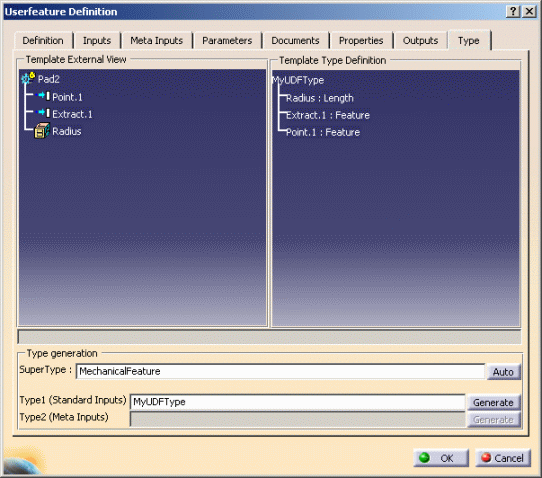 |
This task explains how to reference User Features like any
other existing types. |
 |
- User Features can define new types of objects created by you and can
therefore be searched for like any other type. They are also available in
the Knowledge Expert browser.
- If you want other users to use the User Feature you created, you will
have to provide them with the User Feature, the catalog in which it is
stored (if stored in a catalog), and the CATGScript file.
|
 |
Select a Reference Directory For Types in the
Tools>Options>General>Parameters and Measure>Knowledge Environment
tab. This directory will contain the created user types (.CATGScript
files). This way, user types will be persistent from a CATIA V5 session to
another. |
 |
-
Open the
Pktudfcreateatype.CATPart document.
Pay attention to the Assemble.2 object. This object is the one we are
going to use to create a User Feature.
-
Select Insert>KnowledgeTemplates>Userfeature...
from the standard menu bar if you are currently working with the
Part Design or Generative Shape Design workbenches or click the
Create a User Feature icon ( )
if you are in the PKT workbench. )
if you are in the PKT workbench.
-
The Userfeature definition window opens.
- In the Definition tab, replace the default User
Feature name (enter Pad2 as a new name for example) then select
the Assemble.2 object in the specification tree.
|
- In the Parameters tab, publish the parameter that
will be published. To do so, select `Body.2\Open_body.1\Circle.2\Circle
center radius.1\Radius`,
select the Published Name check box and change the
name of the parameter (Radius for example).
|
- In the Super type field, click the Auto
button. MechanicalFeature is displayed in the Super type field.
Note that the super type is automatically displayed by the
application. The super type can be: MechanicalFeature or
Skinfeature.
- In the Type 1 field, enter the name of the type
that you want to assign to the User Defined Feature (MyUDFType in
this scenario) and click Generate.
|
|
 |
-
Click OK to exit the User Feature
dialog. The Pad2 User Feature is added to the specification tree right
below the KnowledgeTemplates node.
|
 |
See the Quick Reference
topic for a comprehensive list of the interactions that can be carried out
on User Features. |
![]()
![]()